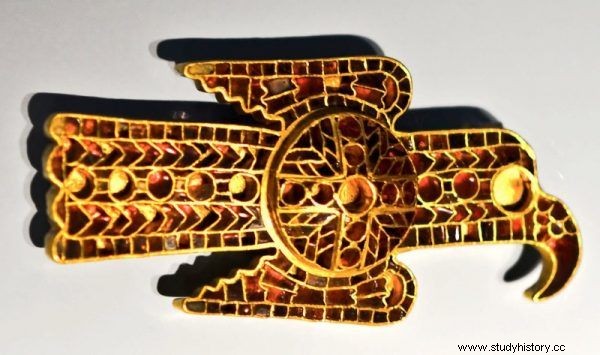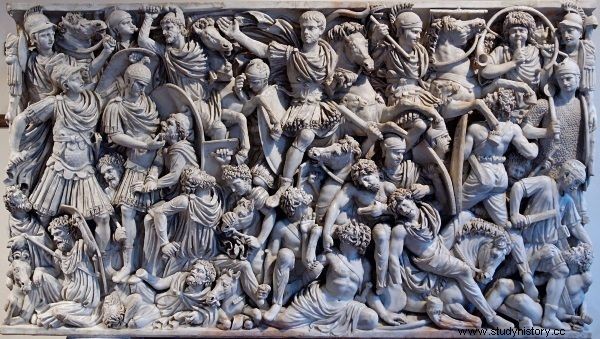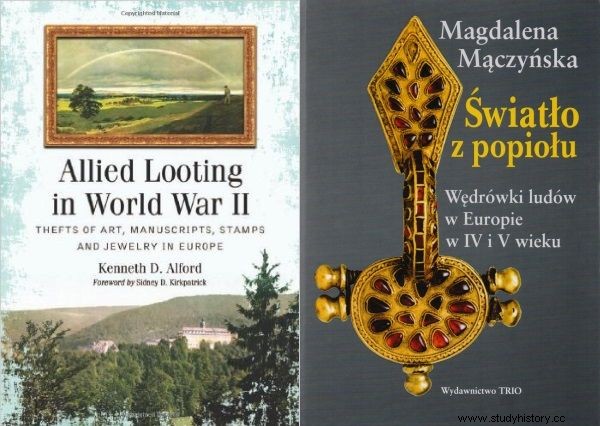You are not satisfied with what you found under the Christmas tree? You can follow in the footsteps of Heinrich Himmler in the future. When he did not like the facts about the history of the Germanic peoples, he decided to brazenly tweak them. His helpers even went so far as to fake ancient relics.
As Nazi Germany finally fell into decline, Himmler frantically tried to save his wealth. At his request, one small clasp in the shape of an eagle was taken to the Berg Castle on Lake Starnberg. Then, meticulously locked in a casket, it was buried in the park.
Today we will not find it in any collection. Shortly after the war, American sappers searched the park. One of them probably stumbled upon this unexpected find. And I think he just appropriated them, because the trace of the monument suddenly broke off.
A nostalgic jewel
Why was this little detail so important to Himmler? The eagle-shaped clasp was considered a monument from the 5th century, attributed to the Germanic Goths, and the Nazis eagerly used the symbolism of the eagle. The monument therefore perfectly matched the demand for references to the glorious past. It provided the basis for a story about the period of migration of peoples, when Germanic tribes with the symbol of the eagle traveled all over Europe (and not only it).

Heinrich Himmler loved vintage trinkets…
In such a political atmosphere, it was difficult for anyone who dared to say that the elegant notation with the Goths had nothing to do with. In fact, this is simply a fake.
Archaeologist Magdalena Mączyńska, author of the book “Light from the ashes. Migrations of peoples in Europe in the fourth and fifth centuries ”, he writes about this matter:
False golden brooches and buckles from the Migration Period appeared before WWII in Spain and France, but none of them caused such a scandal and gained such fame, like a clasp "from Moravia".
The discovery of the clasp was published in 1937 in the Nazi magazine "Germanen-Erbe" by the Munich art historian Frederic Adam van Scheltema. It was to be found in northern Moravia, in the village of Klimkovice (then Königsberg) and was described as Gothic. Van Scheltema brokered its sale to the Germanic National Museum in Nuremberg.

Authentic Gothic eagle. Fibula from around 500 in the collection of the museum in Nuremberg (photo:Pirkheimer, license CC ASA 3.0).
The clasp is made of gold. It weighed 196 g. The eagle's eye was made of rock crystal and the almandides were placed on the body. The form and workmanship resembled brooches from the period of migration of peoples from Italy and Spain.
What caused your doubts?
Soon after its publication in Germanen-Erbe, some archaeologists expressed their skepticism about the find. It was difficult to find an explanation how the Gothic clasp made its way to the north of Moravia. The mysterious mass on the back of the brooch was not patina, but had the same composition as the analogous layer on another forgery from Alsace. In addition, Klimkovice has not heard of any excavations resulting in the finding of a brooch.
Doubts grew, but the atmosphere did its job. It was known what the party expected. It had to be an authentic monument! Another proof that the Nazis only continue the traditions of prehistoric peoples ...
In another article from 1941, Adam van Scheltema strongly defended the authenticity of the brooch. The Office for Prehistoric Monuments followed his opinion. In 1942, officials decided to relieve scientists of the burden of the case. The authenticity of the monument was considered unmistakable and the entire discussion was cut short.
A good forgery is the basis of a porfolio!
For the matter to be successful, the war had to end first. The forgery came to light by accident. Here in 1949 a certain Munich goldsmith, a certain Luitpold Pirzl, applied to the Monuments Protection Office.

A romantic image of Gothic warriors. 19th century illustration.
He tried to have metal relics be restored to him. As proof of his high qualifications, he presented photos of gold objects made by him and his brother-in-law. These were, as he said, "stylistic imitations". Ordinary props, only pretending to be a jewel.
Among these imitations was ... a clasp from Klimkovice.
This article has more than one page. Please select another one below to continue reading.Attention! You are not on the first page of the article. If you want to read from the beginning click here.
There were many similar fakes
Pirzl also made many other imitations of monuments of Germanic art. He did it at the request of the art dealer Herbert von der Marwitz, who had already been arrested before the war for fraud. Marwitz sold these fakes to museum institutions. It was he who used Scheltema as an intermediary to sell the Moravian clasp to the Nuremberg museum.

The fight of the Goths with the Romans. Bas-relief from the 3rd century CE (public domain).
Another Pirzl forgery was an alleged treasure from the town of Szirák in northern Hungary consisting of golden brooches, a necklace, several rings and one genuine Constantius II coin from 353. But this is not the end. Leading his practice on a large scale, Marwitz also used the services of other goldsmiths, which he never disclosed.
Science in the service of ideology
Could Marwitz have acted just as effectively in other circumstances? There was a great demand in Nazi Germany for discoveries that fit in with the myth of Germanic greatness. Hitler's acolytes were furiously searching for the ancient hinterland for their symbolism and political rituals.

The Nazis violently tried to add historical pseudo-facts to their ideology ...
This is why Himmler founded the Ahnenerbe, a scientific institution to prove the superiority of the Aryan race through historical, archaeological and anthropological research. After the outbreak of the war, this organization plundered works of art, library archives, and archaeological relics. In ideological madness, care for the truth gave way to the need to confirm a predetermined vision.
The counterfeiter attacks from beyond the grave
This story kind of ends with a happy ending. Marwitz's criminal activity saw the light of day. He was arrested in Italy, where he fled shortly after the first doubts about the Klimkovice clasp appeared. Many counterfeit products have been found in his Munich apartment that he has not yet had time to sell. After careful research by archaeologists, their authenticity was excluded. In a trial in 1940, he was sentenced to five years in prison.

Above, two books dealing with Nazi forgeries. Among other things, we based our article on them.
The whole thing had one more episode recently. In April 2001, a diver stumbled upon a golden cauldron with images of mythological figures at the bottom of Lake Chiemsee (near Munich). The Bavarian State Archaeological Museum estimated the value of the item at around $ 100,000 and put it up for auction. Before the transaction took place, however, scientists discovered the fake.
The mythological scenes on the vessel were inspired by Nazi heroic ideology. Once again, the shadow of suspicion fell on Marwitz…
